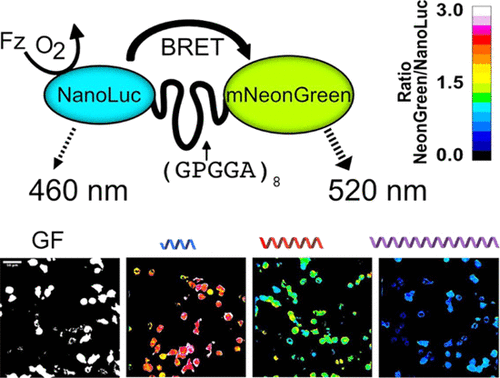Our official English website, www.x-mol.net, welcomes your
feedback! (Note: you will need to create a separate account there.)
Enhanced Molecular Tension Sensor Based on Bioluminescence Resonance Energy Transfer (BRET).
ACS Sensors ( IF 8.2 ) Pub Date : 2020-01-08 , DOI: 10.1021/acssensors.9b00796 Eric J Aird 1 , Kassidy J Tompkins 1 , Maria Paz Ramirez 1 , Wendy R Gordon 1
ACS Sensors ( IF 8.2 ) Pub Date : 2020-01-08 , DOI: 10.1021/acssensors.9b00796 Eric J Aird 1 , Kassidy J Tompkins 1 , Maria Paz Ramirez 1 , Wendy R Gordon 1
Affiliation

|
Molecular tension sensors measure piconewton forces experienced by individual proteins in the context of the cellular microenvironment. Current genetically encoded tension sensors use FRET to report on extension of a deformable peptide encoded in a cellular protein of interest. Here, we present the development and characterization of a new type of molecular tension sensor based on bioluminescence resonance energy transfer (BRET), which exhibits more desirable spectral properties and an enhanced dynamic range compared to other molecular tension sensors. Moreover, it avoids many disadvantages of FRET measurements in cells, including autofluorescence, photobleaching, and corrections of direct acceptor excitation. We benchmark the sensor by inserting it into the canonical mechanosensing focal adhesion protein vinculin, observing highly resolved gradients of tensional changes across focal adhesions. We anticipate that the BRET tension sensor will expand the toolkit available to study mechanotransduction at a molecular level and allow potential extension to an in vivo context.
中文翻译:

基于生物发光共振能量转移(BRET)的增强型分子张力传感器。
分子张力传感器可测量细胞微环境中单个蛋白质所承受的皮克顿力。当前的遗传编码张力传感器使用FRET报告在目标细胞蛋白中编码的可变形肽的延伸。在这里,我们介绍基于生物发光共振能量转移(BRET)的新型分子张力传感器的开发和特性,与其他分子张力传感器相比,该传感器表现出更理想的光谱特性和更大的动态范围。而且,它避免了细胞中FRET测量的许多缺点,包括自发荧光,光漂白和直接受体激发的校正。我们通过将传感器插入规范的机械传感粘着斑蛋白vinculin中来对传感器进行基准测试,观察到粘着斑之间张力变化的高度解析梯度。我们预计BRET张力传感器将扩展可用于在分子水平上研究机械转导的工具包,并允许潜在地扩展到体内。
更新日期:2020-01-08
中文翻译:

基于生物发光共振能量转移(BRET)的增强型分子张力传感器。
分子张力传感器可测量细胞微环境中单个蛋白质所承受的皮克顿力。当前的遗传编码张力传感器使用FRET报告在目标细胞蛋白中编码的可变形肽的延伸。在这里,我们介绍基于生物发光共振能量转移(BRET)的新型分子张力传感器的开发和特性,与其他分子张力传感器相比,该传感器表现出更理想的光谱特性和更大的动态范围。而且,它避免了细胞中FRET测量的许多缺点,包括自发荧光,光漂白和直接受体激发的校正。我们通过将传感器插入规范的机械传感粘着斑蛋白vinculin中来对传感器进行基准测试,观察到粘着斑之间张力变化的高度解析梯度。我们预计BRET张力传感器将扩展可用于在分子水平上研究机械转导的工具包,并允许潜在地扩展到体内。











































 京公网安备 11010802027423号
京公网安备 11010802027423号